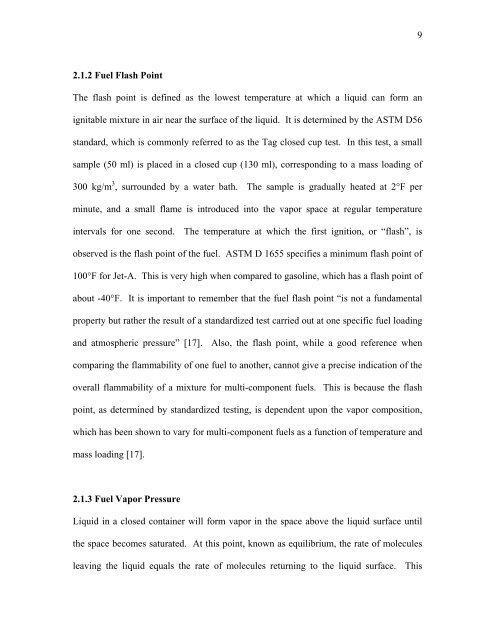Vaporization of JP-8 Jet Fuel in a Simulated Aircraft Fuel Tank ...
Vaporization of JP-8 Jet Fuel in a Simulated Aircraft Fuel Tank ...
Vaporization of JP-8 Jet Fuel in a Simulated Aircraft Fuel Tank ...
Create successful ePaper yourself
Turn your PDF publications into a flip-book with our unique Google optimized e-Paper software.
2.1.2 <strong>Fuel</strong> Flash Po<strong>in</strong>t<br />
The flash po<strong>in</strong>t is def<strong>in</strong>ed as the lowest temperature at which a liquid can form an<br />
ignitable mixture <strong>in</strong> air near the surface <strong>of</strong> the liquid. It is determ<strong>in</strong>ed by the ASTM D56<br />
standard, which is commonly referred to as the Tag closed cup test. In this test, a small<br />
sample (50 ml) is placed <strong>in</strong> a closed cup (130 ml), correspond<strong>in</strong>g to a mass load<strong>in</strong>g <strong>of</strong><br />
300 kg/m 3 , surrounded by a water bath. The sample is gradually heated at 2°F per<br />
m<strong>in</strong>ute, and a small flame is <strong>in</strong>troduced <strong>in</strong>to the vapor space at regular temperature<br />
<strong>in</strong>tervals for one second. The temperature at which the first ignition, or “flash”, is<br />
observed is the flash po<strong>in</strong>t <strong>of</strong> the fuel. ASTM D 1655 specifies a m<strong>in</strong>imum flash po<strong>in</strong>t <strong>of</strong><br />
100°F for <strong>Jet</strong>-A. This is very high when compared to gasol<strong>in</strong>e, which has a flash po<strong>in</strong>t <strong>of</strong><br />
about -40°F. It is important to remember that the fuel flash po<strong>in</strong>t “is not a fundamental<br />
property but rather the result <strong>of</strong> a standardized test carried out at one specific fuel load<strong>in</strong>g<br />
and atmospheric pressure” [17]. Also, the flash po<strong>in</strong>t, while a good reference when<br />
compar<strong>in</strong>g the flammability <strong>of</strong> one fuel to another, cannot give a precise <strong>in</strong>dication <strong>of</strong> the<br />
overall flammability <strong>of</strong> a mixture for multi-component fuels. This is because the flash<br />
po<strong>in</strong>t, as determ<strong>in</strong>ed by standardized test<strong>in</strong>g, is dependent upon the vapor composition,<br />
which has been shown to vary for multi-component fuels as a function <strong>of</strong> temperature and<br />
mass load<strong>in</strong>g [17].<br />
2.1.3 <strong>Fuel</strong> Vapor Pressure<br />
Liquid <strong>in</strong> a closed conta<strong>in</strong>er will form vapor <strong>in</strong> the space above the liquid surface until<br />
the space becomes saturated. At this po<strong>in</strong>t, known as equilibrium, the rate <strong>of</strong> molecules<br />
leav<strong>in</strong>g the liquid equals the rate <strong>of</strong> molecules return<strong>in</strong>g to the liquid surface. This<br />
9
















